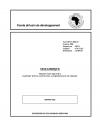Evaluation Team
This evaluation report was prepared by Operations Evaluation Department’s (OPEV) Evaluation Experts: Mrs. G. Yirga-Hall and Mr. F. Botes (f.botes@afdb.org )following the mission to Mozambique. Mr. J. Quintana (Environmental Specialist and Consultant) carried out an environment audit on the project for which a separate report is available. Any further matters relating to this report may be refereed to Mr. D. Barnett, Acting Director, OPEV or to the two experts.
Objective
At the time of appraisal the peak demand in Mozambique was still comfortably below 300 MW, with the result that the Government’s priority was to expand the national grid network to supply electric power to the rural areas. Thus, as was the case with Electricity I in 1991 (a Bank financed project), Electricity II Project (the subject of this evaluation) was conceived with the objective of extending the national grid network through medium and low voltage lines to the southern provinces of Maputo and Gaza.It was the project’s aim to provide reliable electric power to serve primarily as a catalyst for the resettlement of the displaced persons from the prolonged civil wars. The project was expected to meet the energy requirements for industrial and domestic applications and gradually reverse the degradation of the environment. The main components of the project comprised medium and low voltage transmission lines and distribution systems including the associated substations, materials for customer connections and operating logistics.
Main Findings
- Overall, the project has been a success and contributes to the socio-economic development of the rural southern areas of the Mozambique. Electricity II reflects several good practices. However, the project has performed less than satisfactory in a number of specific areas.
- There were significant delays in the implementation of the project. Although a natural disaster contributed to the delays, there are also other reasons, including: (a) Staff at the Executing Agency’s implementation unit was not fully familiar with all the Bank procedures prior to commencement of the project. (b) There was not sufficient capacity at the Executing Agency’s implementation unit to deal with a number of similar projects simultaneously. (c) The implementation timeframe might have been overly optimistic given that Mozambique was a fragile state emerging from prolonged periods of strife and instability. Its capacity limitations in dealing with a number of similar projects from multiple donors, as well as a severe flood, meant that delays were inevitable. (d) A temporary suspension of construction due to environmentally damaging construction techniques.
- It should be recognised that economically viable projects does not necessarily have a high financial rate of return to the operator or public utility. The project has significant secondary spin-offs that cannot easily be reflected in the socio-economic analysis.
- The project has significant secondary spin-offs that cannot easily be reflected in the socio-economic analysis. These benefits include the following: (a) Since completion, the line has been extended to a number of tourist lodges through a private-public-partnership agreement. A significant number of rural households could be electrified because of this. (b) The provision of electricity had a significant impact on the voluntary resettlement of people that were displaced during the civil war. The Electricity II project encouraged displaced communities to resettle in towns that they deserted during the civil war and attracted communities to the vicinity of the electricity line where they can get electrical connections.
- Given the number of new connections due to the expansion of the electricity grid, as well as the fact that there are no immediate plans to add additional generating capacity, there is a potential for future electricity shortages. Under these circumstances, it would be unwise to undertake further large-scale rural electrification projects without specific plans to cope with the increase in demand.
Main Lessons
- Delays at start-up can be minimized/avoided if: (a) The Bank ensures appropriate and timely training in Bank procedures for staff at the Executing Agency. (b) An implementation capacity assessment is made; and (c) A realistic implementation timeframe is set, particularly in the case of fragile states
- Financial sustainability of rural public utility projects where local residents are unable to afford the full commercial tariff (long term marginal cost tariff) can be improved if the following principles are adhered to: (a) Services cover at least the short term marginal cost and should not be provided at an outright loss or for free. (b) The borrower develops an appropriate financial package to compensate the public utility company for the social services that it provides in areas where full cost recovery is not possible. (c) Electricity supply/generating capacity keeps up with the long term growth in the combined demand of all electricity projects. (d) Institutional development remains an integral component of the project.
- Rural electrification projects have significant secondary spin-offs and opportunities which should be investigated and promoted as part of project appraisal process. These include the following: (a) Public-private-partnerships to extend the line and connecting additional users. (b) Positive impacts on rural settlement patterns and land-use.
- Possible negative environmental consequences can be minimized or avoided altogether if an environmentalist is included in the appraisal and monitoring processes, even if there are no obvious environmentally sensitive issues at the time of categorisation.
| Attachment | Size |
|---|---|
| 324.98 KB |


